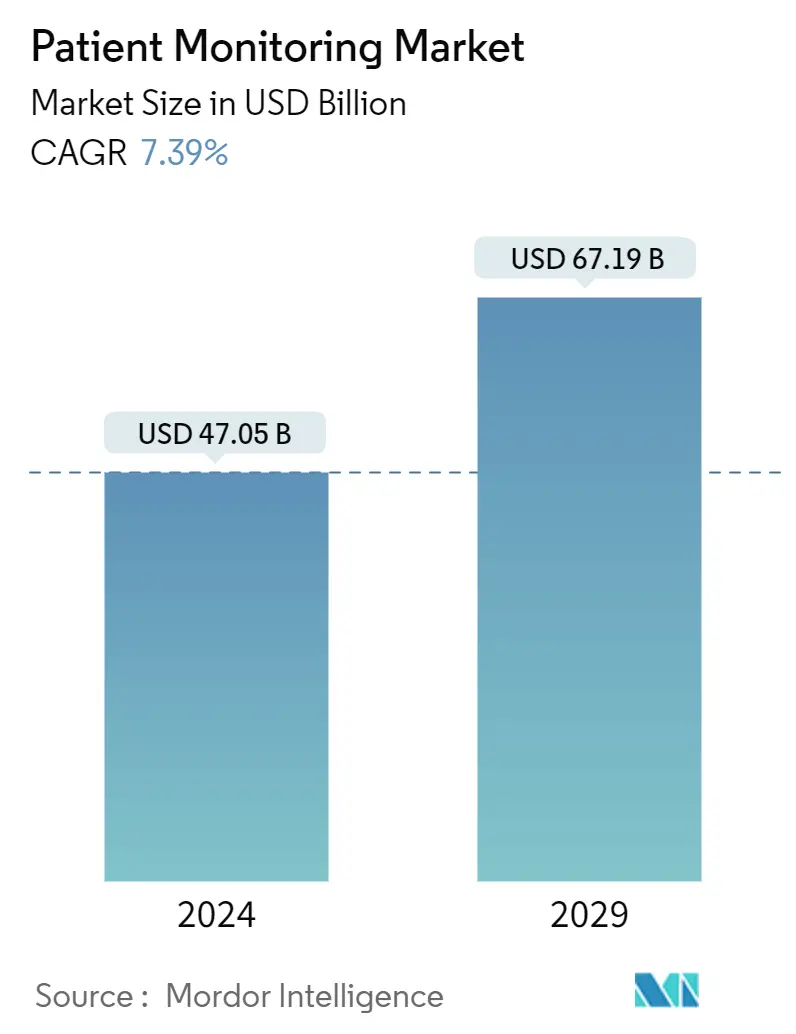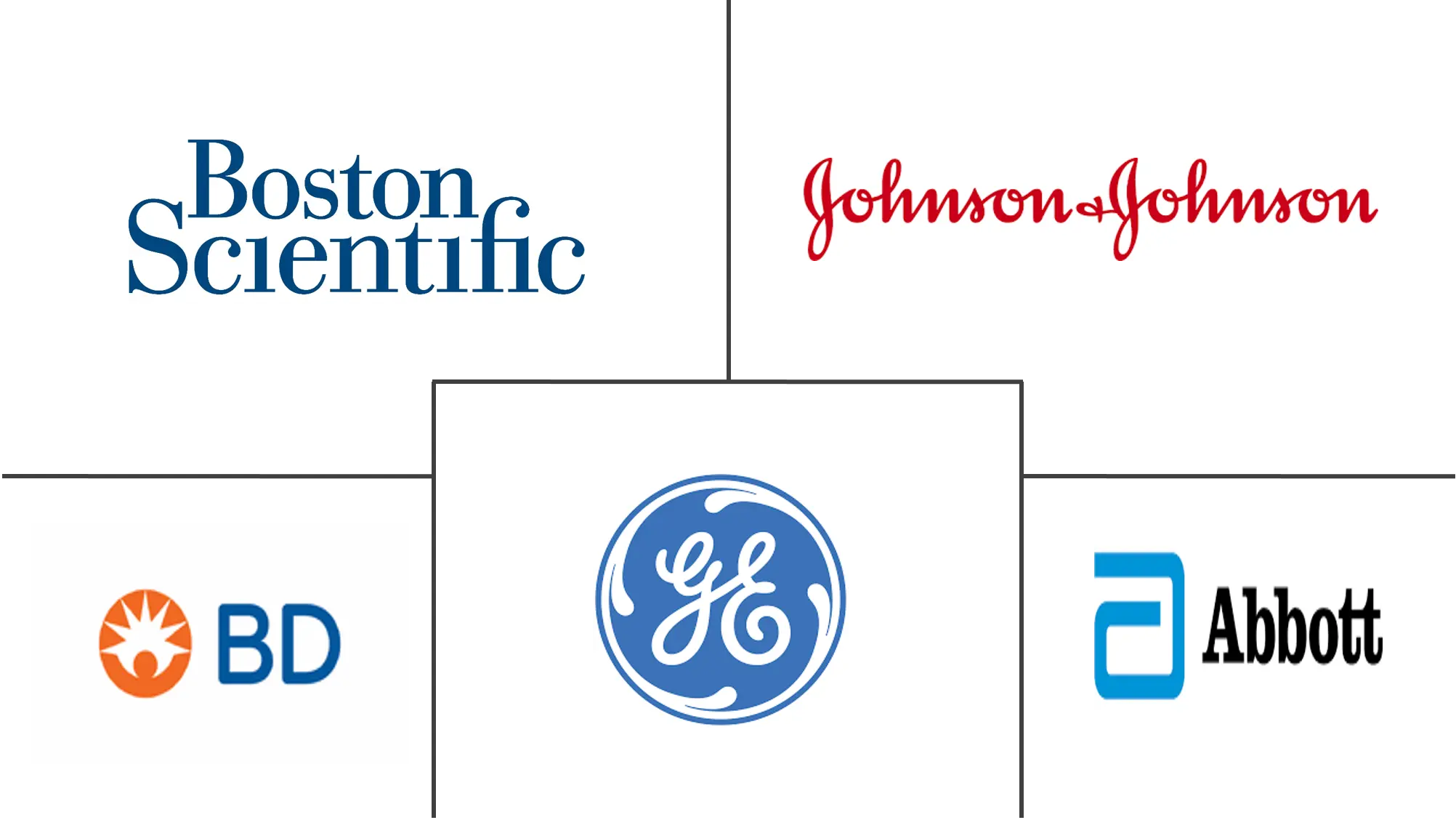Market Size of Patient Monitoring Industry

| Study Period | 2019 - 2029 |
| Market Size (2024) | USD 47.05 Billion |
| Market Size (2029) | USD 67.19 Billion |
| CAGR (2024 - 2029) | 7.39 % |
| Fastest Growing Market | Asia Pacific |
| Largest Market | North America |
| Market Concentration | Medium |
Major Players
*Disclaimer: Major Players sorted in no particular order |
Patient Monitoring Market Analysis
The Patient Monitoring Market size is estimated at USD 47.05 billion in 2024, and is expected to reach USD 67.19 billion by 2029, growing at a CAGR of 7.39% during the forecast period (2024-2029).
The outbreak of the pandemic impacted the Patient Monitoring Market significantly. During the pandemic, the demand for patient monitoring devices such as neuromonitoring, respiratory, and cardiac devices drastically increased due to the need for constant monitoring of COVID-19 patients. For instance, according to the NCBI study published in October 2022, wearable respiratory sensors were widely used during the pandemic as they can monitor biomechanical signals, such as the abnormalities in respiratory rate and cough frequency caused by COVID-19, as well as biochemical signals, such as viral biomarkers from exhaled breaths. Thus, the Digital Patient Monitoring Devices Market witnessed healthy growth during the pandemic and is expected to maintain an upward trend over the forecast period.
The growth of the Patient Monitoring Market is attributed to the rising burden of chronic diseases due to lifestyle changes, growth in the geriatric population, growing preference for home and Remote Patient Monitoring, and the ease of use of portable devices. For instance, according to the June 2022 update of the Centers for Disease Control and Prevention (CDC), one or more chronic diseases, such as diabetes, cancer, heart disease, and stroke, affect six out of ten Americans. These and other chronic illnesses are the main contributors to health care costs and the significant causes of death and disability in the United States. Similarly, according to the data published by the NCBI in April 2022, an estimated 6.5 million Americans aged 65 and older were living with Alzheimer's dementia in 2022. The number is expected to grow to 13.8 million by 2060. Thus, such a high burden of chronic diseases is expected to increase the demand for products in the Patient Monitoring Devices Market as these diseases require constant monitoring, in which patient monitoring devices come into play. In addition, constant monitoring reduces readmission rates, prevents avoidable hospitalizations, decreases the number of unnecessary trips to the doctor's office, and reduces travel-related expenses. With the proper implementation, patient monitoring technologies can expand access to quality healthcare and save time and money. Thus, considerable market growth is expected over the forecast period due to such factors.
Additionally, initiatives such as expansion and product launches are other factors responsible for the market's growth. For instance, in September 2021, the Indian subsidiary of Medtronic partnered with Stasis Health to expand access to Stasis Monitor, a connected care bedside Multiparameter Patient Monitoring System across India. Similarly, in July 2021, Terumo Corporation launched Japan's Dexcom G6 continuous glucose monitoring system. Dexcom, Inc., based in the United States, manufactures the product, and Terumo holds the exclusive distribution agreement in Japan. Such developments are likely to bolster the growth of the Patient Monitoring Market over the forecast period.
However, resistance from healthcare industry professionals toward adopting Patient Monitoring Systems and the high cost of technology will likely hinder the market growth over the forecast period.
Patient Monitoring Industry Segmentation
As per the scope of this report, patient monitoring devices are monitoring devices that continuously monitor the patient's vital parameters, like blood pressure and heart rate, by using a medical monitor and collecting medical (and other) data from individuals. The patient monitoring market is segmented by type of device (hemodynamic monitoring devices, neuromonitoring devices, cardiac monitoring devices, multi-parameter monitors, respiratory monitoring devices, remote patient monitoring devices, and other types of devices), application (cardiology, neurology, respiratory, fetal and neonatal, weight management and fitness monitoring, and other devices), end user (home care settings, hospital and clinics, and other end users), and geography (North America, Europe, Asia-Pacific, Middle East and Africa, and South America). The report also covers the estimated market sizes and trends for 17 countries across major regions globally. The report offers the value (in USD) for the segments mentioned above.
| By Type of Device | |
| Hemodynamic Monitoring Devices | |
| Neuromonitoring Devices | |
| Cardiac Monitoring Devices | |
| Multi-parameter Monitors | |
| Respiratory Monitoring Devices | |
| Other Types of Devices |
| By Application | |
| Cardiology | |
| Neurology | |
| Respiratory | |
| Fetal and Neonatal | |
| Weight Management and Fitness Monitoring | |
| Other Applications |
| By End-User | |
| Home Healthcare | |
| Hospitals and Clinics | |
| Other End-Users |
| Geography | ||||||||
| ||||||||
| ||||||||
| ||||||||
| ||||||||
|
Patient Monitoring Market Size Summary
The patient monitoring devices market is poised for significant growth, driven by the increasing prevalence of chronic diseases, a growing geriatric population, and the rising demand for home and remote monitoring solutions. The COVID-19 pandemic has further accelerated the adoption of these devices, as constant monitoring became crucial for managing infected patients. The market is characterized by the development and deployment of advanced technologies, such as wearable sensors and portable devices, which enhance the ease of use and accessibility of healthcare services. Despite challenges like resistance from healthcare professionals and high technology costs, the market is expected to expand due to ongoing product innovations and strategic partnerships among key industry players.
North America is anticipated to be a major contributor to the market's growth, with the United States leading due to its robust healthcare infrastructure and frequent product launches. The region's large market share is attributed to the increasing incidence of chronic conditions, a substantial elderly population, and favorable reimbursement policies. The competitive landscape is marked by the presence of several prominent companies, including Abbott Laboratories, Boston Scientific Corporation, and GE Healthcare, which are actively engaging in mergers, acquisitions, and new product introductions to strengthen their market positions. These strategic initiatives, coupled with technological advancements, are expected to drive the market forward, offering enhanced patient monitoring solutions and improving healthcare outcomes.
Patient Monitoring Market Size - Table of Contents
-
1. MARKET DYNAMICS
-
1.1 Market Overview
-
1.2 Market Drivers
-
1.2.1 Rising Burden of Chronic Diseases due to Lifestyle Changes
-
1.2.2 Growing Preference for Home and Remote Monitoring
-
-
1.3 Market Restraints
-
1.3.1 Resistance from Healthcare Industry Professionals Toward the Adoption of Patient Monitoring Systems
-
1.3.2 High Cost of Technology
-
-
1.4 Porter's Five Forces Analysis
-
1.4.1 Bargaining Power of Buyers/Consumers
-
1.4.2 Bargaining Power of Suppliers
-
1.4.3 Threat of New Entrants
-
1.4.4 Threat of Substitute Products
-
1.4.5 Intensity of Competitive Rivalry
-
-
-
2. MARKET SEGMENTATION (Market Size by Value - USD)
-
2.1 By Type of Device
-
2.1.1 Hemodynamic Monitoring Devices
-
2.1.2 Neuromonitoring Devices
-
2.1.3 Cardiac Monitoring Devices
-
2.1.4 Multi-parameter Monitors
-
2.1.5 Respiratory Monitoring Devices
-
2.1.6 Other Types of Devices
-
-
2.2 By Application
-
2.2.1 Cardiology
-
2.2.2 Neurology
-
2.2.3 Respiratory
-
2.2.4 Fetal and Neonatal
-
2.2.5 Weight Management and Fitness Monitoring
-
2.2.6 Other Applications
-
-
2.3 By End-User
-
2.3.1 Home Healthcare
-
2.3.2 Hospitals and Clinics
-
2.3.3 Other End-Users
-
-
2.4 Geography
-
2.4.1 North America
-
2.4.1.1 United States
-
2.4.1.2 Canada
-
2.4.1.3 Mexico
-
-
2.4.2 Europe
-
2.4.2.1 Germany
-
2.4.2.2 United Kingdom
-
2.4.2.3 France
-
2.4.2.4 Italy
-
2.4.2.5 Spain
-
2.4.2.6 Rest of Europe
-
-
2.4.3 Asia-Pacific
-
2.4.3.1 China
-
2.4.3.2 Japan
-
2.4.3.3 India
-
2.4.3.4 Australia
-
2.4.3.5 South Korea
-
2.4.3.6 Rest of Asia-Pacific
-
-
2.4.4 Middle East and Africa
-
2.4.4.1 GCC
-
2.4.4.2 South Africa
-
2.4.4.3 Rest of Middle East and Africa
-
-
2.4.5 South America
-
2.4.5.1 Brazil
-
2.4.5.2 Argentina
-
2.4.5.3 Rest of South America
-
-
-
Patient Monitoring Market Size FAQs
How big is the Patient Monitoring Market?
The Patient Monitoring Market size is expected to reach USD 47.05 billion in 2024 and grow at a CAGR of 7.39% to reach USD 67.19 billion by 2029.
What is the current Patient Monitoring Market size?
In 2024, the Patient Monitoring Market size is expected to reach USD 47.05 billion.

